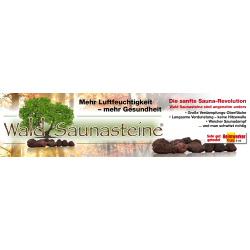






Mehr Luftfeuchtigkeit - mehr Gesundheit
Körnung: 40-80mm
8kg Verpackungsgewicht pro Einheit (3,65€/Kg exkl. Mwst)

Vorteile der Wald Saunasteine gegenüber herkömmlichen Saunasteinen:
• weicher Saunadampf
• langsame Verdunstung - keine Hitzewelle
• grosse Verdampfungs-Oberfläche
• längerer Aufguss - Intervall
Wald Saunasteine sind bestens geeignet um die Luftfeuchtigkeit in der Sauna zu erhöhen. Diese Wald Steine sind anders. Genau genommen sind diese Steine das Gegenteil bekannter Granit-Saunasteine. Wald Saunasteine sind porös und nehmen das Wasser in sich auf. Dadurch kommt es nicht zu der üblichen Hitzewelle und zu einer abrupten Verdunstung. Statt dessen verdunstet das Wasser allmählich über einen langen Zeitraum und es stellt sich ein besonders angenehmes Gefühl ein. Besonders von Frauen wird dies geschätzt.

Dieser nur bei den Wald Saunasteinen typische, weiche Saunadampf entsteht auch durch die insgesamt größere Verdampfungs-Oberfläche. Wald Saunasteine kommen direkt aus der Natur und riechen nach Wald. Nach einigen Saunaaufgüssen verschwindet dieser Geruch. Manche sagen leider…
Wir empfehlen die Wald Saunasteine vor der Benutzung zu waschen. Wald Saunasteine werden locker geschichtet.
Für ein lang anhaltend, optimales Sauna Erlebnis, empfiehlt es sich, die Steine alle 1-2 Jahre auszutauschen, da sich über die Zeit die Poren zusetzen können. Je kalkhaltiger das Wasser, um so schneller tritt dieser Effekt ein. Wir empfehlen die Wald Saunasteine auf vorhandene Steine aufzulegen.
Guten Tag,
gestern Abend bei der Teambesprechung habe ich die Wald-Sauna-Steine angesprochen und das Saunapersonal hat bestätigt, dass es durch den Einsatz der Steine zu einem besseren Raumklima in der Finnischen Sauna gekommen ist. Wir haben die Steine in unserer finnnischen Sauna, (keine Aufgusssauna) eingesetzt weil dort vorher ein extrem trockenes Klima war. Der Aufenthalt in dieser Sauna war schon fast unangenehm so trocken war die Luft, Verdampferschalen etc. brachten keine Besserung. Die Wald-Saunasteine werden nun hin und wieder begossen und geben die Feuchtigkeit langsam ab, was zu der Verbesserung geführt hat.
Mit freundlichen Grüßen
Irene D.
Märchenlandtherme, Stadt Breuna
"....die Kunden finden die Wald-Saunasteine klasse. Besonders bei unseren Meditationsaufgüssen sind die Steine sehr gefragt. Leise Zischelgeräusche geben einen angenehmen Sound, das längere Schwitzen durch die langsamere Wasserabgabe passen optimal zu unserem Meditationsaufgüssen".
Oliver K.
FinnWell/Freizeitzentrum Xanten
"Seit 2 Jahren sind die Wald-Saunasteine bei mir im Einsatz. Ich bin Heavy User und will nie wieder andere haben. Der weiche Saunadampf ist traumhaft....."
Nolan B. ,Bocholt
"Als ich die Steine sah, wußte ich warum sie besser sind, sie nehmen das Wasser auf und es verdunstet über mehrere Minuten ganz gleichmässig. Vorher hat sich meine Frau über den Aufguß immer beschwert, die plötzliche Verdunstungswelle war ihr zu heiß...."
Arno S. , Lörrach
"Hallo ihr Saunasteiner,
vielen Dank, meine Eltern haben sich riesig über das Geschenk gefreut. Vor allem meine Mutter ist begeistert. Der Saunadampf ist " weich " sagt sie. Sie meint, das Schwitzen kommt noch tiefer aus dem Körper. Ich kann die Waldsaunasteine nur wärmstens empfehlen."
Peter S., Karlsruhe
"Ansonsten kann ich Ihnen nur bestätigen, daß es ein sehr angenehmes Sauna Klima ist. Man kommt auch schon bei niedrigeren Temperaturen sehr schnell zum schwitzen. Einfach toll!"
Karina D.